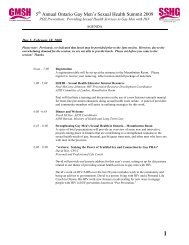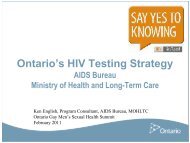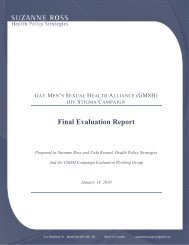Anal Cancer: A Sexually Transmitted Disease - GMSH
Anal Cancer: A Sexually Transmitted Disease - GMSH
Anal Cancer: A Sexually Transmitted Disease - GMSH
Create successful ePaper yourself
Turn your PDF publications into a flip-book with our unique Google optimized e-Paper software.
ANAL CANCER<br />
A <strong>Sexually</strong> <strong>Transmitted</strong><br />
<strong>Disease</strong><br />
February 2008<br />
IRV SALIT<br />
Director,<br />
Immunodeficiency Clinic,<br />
Toronto General Hospital
ANAL CANCER<br />
THE ANAL CANAL
The Case of GR<br />
• 45 year old male with HIV<br />
• He had AIDS<br />
• Was doing very well on ARV’s (1996)<br />
• In 2000, he had anal symptoms and<br />
went to anorectal clinics several<br />
times<br />
• Finally he was diagnosed with anal<br />
cancer<br />
• He needed surgery to remove his<br />
lower bowel<br />
The Case of GR<br />
• He did research and told me about<br />
anal cancer<br />
• We found some ways of preventing<br />
anal cancer
ANAL CANCER<br />
• Uncommon cancer in the general<br />
population<br />
• It involves the anal canal and skin<br />
around the anus<br />
• This is not colon cancer<br />
• Like cervical cancer, it is caused by a<br />
virus called the Human<br />
Papillomavirus (HPV)<br />
• <strong>Anal</strong> cancer has increased<br />
substantially since the 1980s<br />
ANAL CANCER<br />
Symptoms<br />
• The symptoms of anal cancer<br />
resemble those of common anal<br />
problems<br />
• There may be bleeding, pain,<br />
itchiness, swollen glands
ANAL CANCER<br />
Treatment<br />
• Radiation and chemotherapy<br />
• Sometimes bowel removal is<br />
necessary and a colostomy<br />
Age- & Sex-Adjusted <strong>Anal</strong> <strong>Cancer</strong><br />
Incidence, 1971-2002<br />
0.26/100,000 1.06/100,000<br />
J. Tinmouth OHTN Conference 2006
<strong>Anal</strong> <strong>Cancer</strong> is very<br />
similar to Cervical<br />
<strong>Cancer</strong><br />
SCJ: where one type of tissue joins<br />
another type of tissue<br />
<strong>Cancer</strong>s start here at<br />
SCJ
<strong>Anal</strong> cancer in MSM<br />
In MSM:<br />
annual incidence est:<br />
35/100,000<br />
CERVICAL CANCER:<br />
40-50/100,000 annual<br />
incidence (pre ’60s)<br />
ANAL PAP SMEARS<br />
Routine cervical Paps<br />
?annual incidence<br />
8/100,000 annual<br />
incidence<br />
WHO GETS ANAL CANCER?<br />
• MSM<br />
• Poor immune system (HIV,<br />
transplants)<br />
• Especially HIV+ MSM (50-150 fold<br />
risk)<br />
• Women with cervical or vulvar cancer
ANAL CANCER IN OUR HIV<br />
CLINIC<br />
• Second most common cancer<br />
• 1% of the current clinic population<br />
• Most have very immune systems<br />
(CD4) and low viral loads<br />
• As people live longer, there will be<br />
more cancers<br />
HPV
HPV TYPES<br />
• >100 types in humans: 40 infect the<br />
anus and genital tract<br />
• Genital warts: types 6 and 11<br />
• <strong>Cancer</strong>s: types 16, 18, 45, 31, 33, 52,<br />
58 = >95%<br />
Commonest STD<br />
• >75% of sexually active adolescents<br />
and adults, ages 15-49, get at least one<br />
HPV infection during their life<br />
• Likelihood of infection rapidly<br />
increases with first 5 partners<br />
• If HIV-negative, tend to get rid of HPV<br />
and low cancer risk
PRE-CANCEROUS<br />
LESIONS<br />
(Dysplasia)<br />
HPV INFECTION<br />
Normal Tissues<br />
Low grade lesions (AIN1)<br />
High grade lesions (AIN 2/3)<br />
= Dysplasia<br />
<strong>Cancer</strong>
CAN WE PREVENT<br />
ANAL CANCER?<br />
How do we detect<br />
<strong>Anal</strong> Pre-cancer<br />
(Dysplasia) ?
TORONTO<br />
SCREENING STUDY<br />
TORONTO<br />
RESEARCH<br />
for ANAL<br />
CANCER<br />
EVALUATION<br />
TRACE Study
HPV DETECTION<br />
HPV DETECTION<br />
• Any HPV found in about 95%<br />
• High-risk (cancer-producing) types of<br />
HPV were found in about 90% of<br />
men
ANAL CYTOLOGY<br />
(Pap Smear)<br />
ANAL PAP SMEAR<br />
Cell collection
HIGH GRADE CHANGES
HIGH RESOLUTION<br />
ANOSCOPY<br />
(HRA)
NORMAL SQUAMO-COLUMNAR JUNCTION<br />
SQUAMO-COLUMNAR<br />
JUNCTION<br />
RECTUM<br />
ANUS
RESULTS<br />
• <strong>Anal</strong> HPV found in about 95%<br />
• ANAL PAP SMEARS - Abnormal in<br />
66%<br />
• BIOPSY – High-grade grade pre-cancers<br />
(AIN 2/3) in 25%<br />
CAN WE TREAT and<br />
REMOVE ANAL PRE-<br />
CANCERS?
IRC<br />
IRC (Laser)<br />
• Treatment done once<br />
• 20-30 minutes<br />
• Painful so must use freezing<br />
• May have some pain and/or bleeding<br />
for a few days
• Painless<br />
TCA (Acid)<br />
• Quick (5-10 minutes)<br />
• Need repeated visits and treatments<br />
(once per month x 4 months)<br />
WHICH IS BETTER?<br />
Outcomes are the same
CONCLUSION<br />
Routine screening for anal cancer should<br />
be implemented for gay men once<br />
adequate experience has been<br />
gained from studies such as this.<br />
• OHTN<br />
• CANFAR<br />
• NCIC<br />
FUNDING
THANK YOU !
















